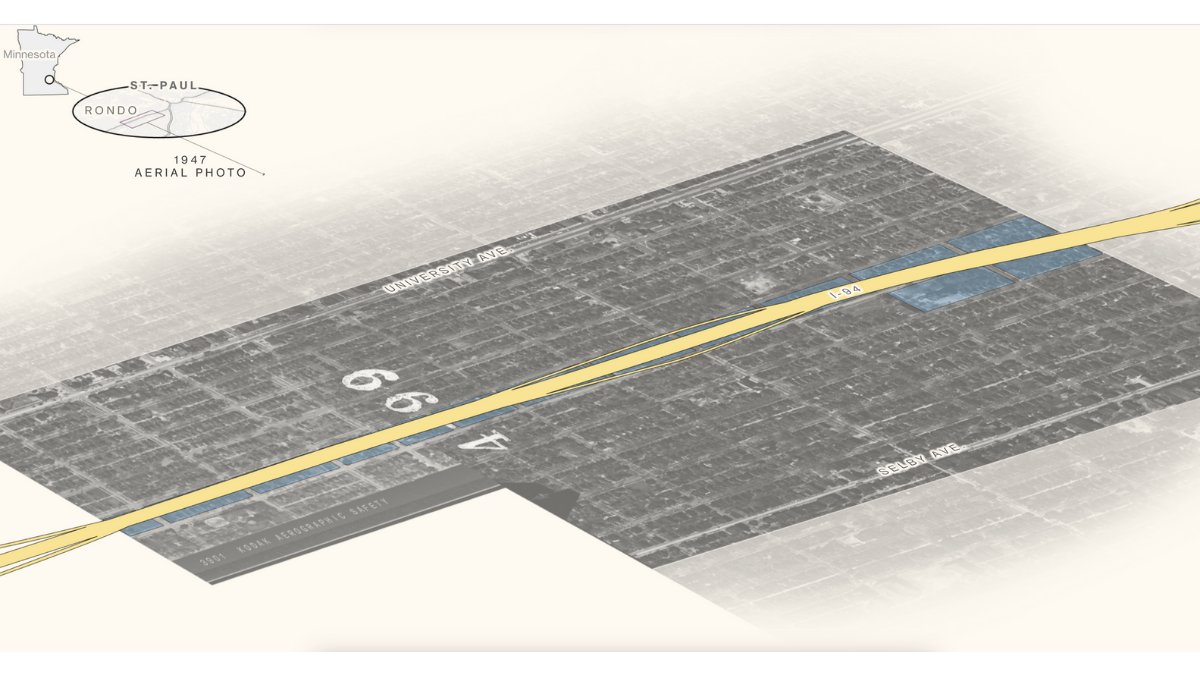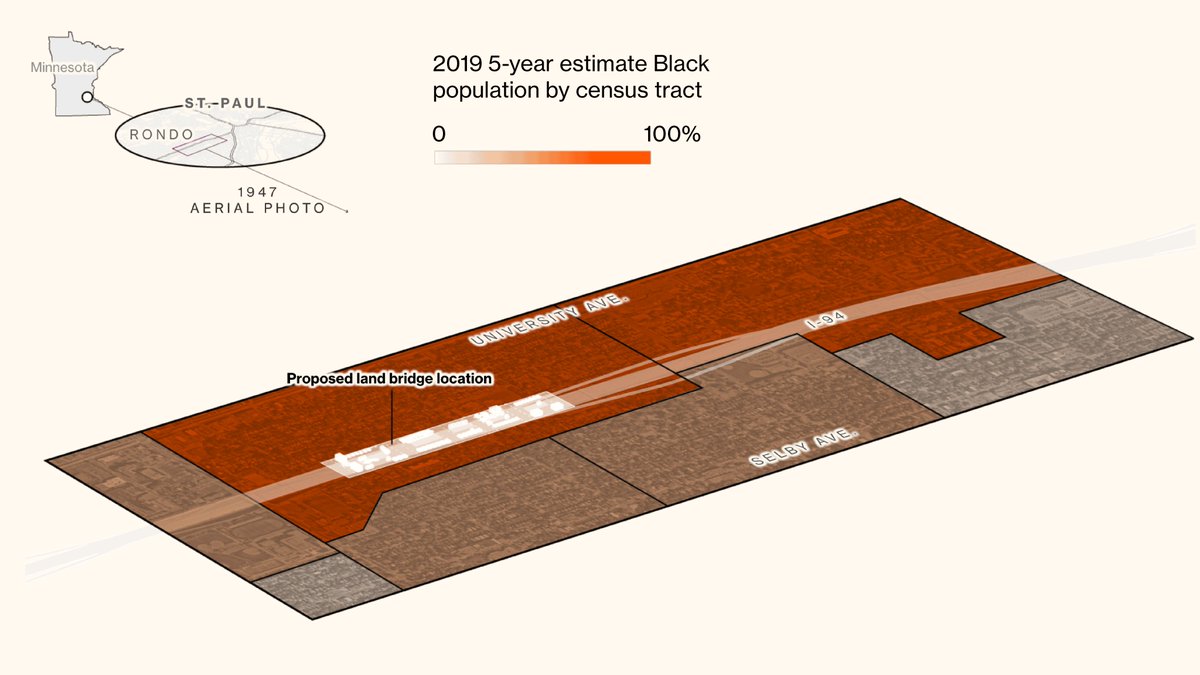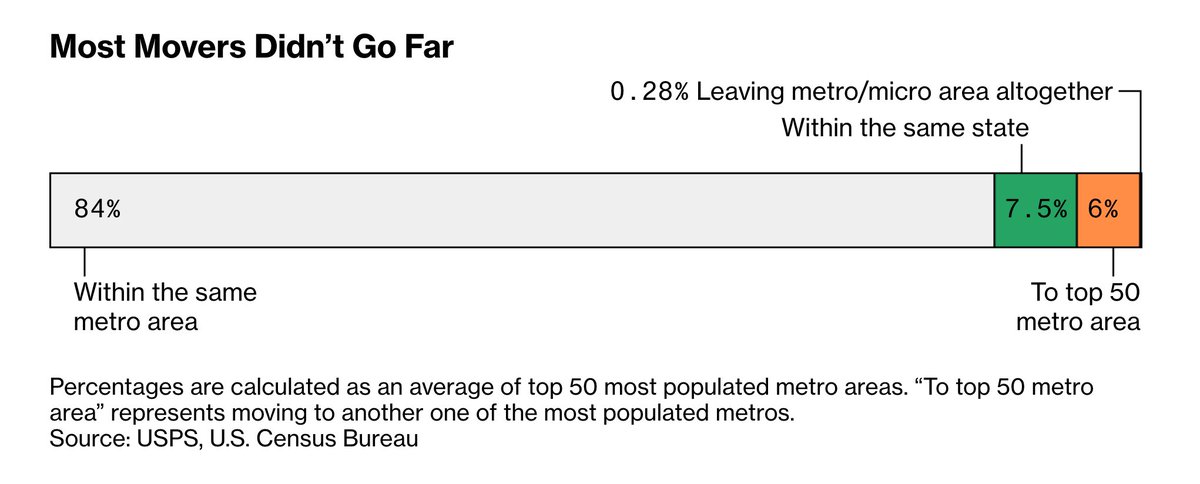
Take any major U.S. city and you're likely to find a historically Black neighborhood demolished or cut off from the rest of the city by a highway.
The legacy of this racist transportation policy continues to define urban landscapes. [THREAD] bloom.bg/3zJrbo2
The legacy of this racist transportation policy continues to define urban landscapes. [THREAD] bloom.bg/3zJrbo2
This map shows the Rondo neighborhood in St. Paul, Minnesota.
In the first half of the 20th century it was home to most of the city's African American residents.
It was a key area to do business, meet, shop and socialize during segregation and the Jim Crow era.
In the first half of the 20th century it was home to most of the city's African American residents.
It was a key area to do business, meet, shop and socialize during segregation and the Jim Crow era.

Construction of I-94 through Rondo began in the mid-1950s.
"As someone who was there ... it was a surreal experience to see it street by street. It's something I've never forgotten," said Marvin Anderson, a Rondo resident and co-founder of ReConnect Rondo.
"As someone who was there ... it was a surreal experience to see it street by street. It's something I've never forgotten," said Marvin Anderson, a Rondo resident and co-founder of ReConnect Rondo.

By the 1960s, the neighborhood's business core was gone, replaced by newly constructed I-94.
Homes that had been a short walk to the shops now overlooked a six-lane highway shuttling commuters between Minneapolis and St. Paul.
The neighborhood was split in two.
Homes that had been a short walk to the shops now overlooked a six-lane highway shuttling commuters between Minneapolis and St. Paul.
The neighborhood was split in two.

Highways like Rondo's were part of a nationwide effort to build the interstate highway system, sometimes in concert with federal urban renewal programs that sought to demolish neighborhoods considered "blighted" in the name of revitalizing cities.
What follows are demographic maps of six other U.S. cities in the 1950s that show examples of how highways devastated established Black communities and hubs across the U.S. 

The Black Bottom neighborhood in Detroit was destroyed to make way for I-75 and I-375.
Centered on Hastings Street, Black-owned businesses lined the streets. Ella Fitzgerald performed in its clubs
Today, few traces of the neighborhood remain aside from historical markers.
Centered on Hastings Street, Black-owned businesses lined the streets. Ella Fitzgerald performed in its clubs
Today, few traces of the neighborhood remain aside from historical markers.

Proposed plans originally routed a riverfront highway along the historic French Quarter of New Orleans, but that was stopped by local activists.
Later, I-10 was built through the Tremé neighborhood, uprooting historic oak trees and hundreds of Black residents and businesses.
Later, I-10 was built through the Tremé neighborhood, uprooting historic oak trees and hundreds of Black residents and businesses.

Urban renewal and the US-27 and Riverfront highways cut off and destroyed Black businesses and homes around the 9th Street neighborhood of Chattanooga.
Communities walled off this way became what are known as "border vacuums," with much less access to resources and jobs.
Communities walled off this way became what are known as "border vacuums," with much less access to resources and jobs.

The West End area of Cincinnati was home to around 25,000 predominantly Black residents who were forced to relocate in the 1950s and 1960s to make way for I-75.
The neighborhood was flattened in the name of urban renewal and rebranded as Queensgate.
The neighborhood was flattened in the name of urban renewal and rebranded as Queensgate.

Established in the early 1900s, Independence Heights was a Black enclave of home- and land-owners, later annexed by the city of Houston.
Hundreds of Black residents in the community were displaced in the 1950s and 1960s by highway construction.
Hundreds of Black residents in the community were displaced in the 1950s and 1960s by highway construction.

In segregated Miami, Overtown was the historic center of Black life.
It became known as the "Harlem of the South" for its lively cultural and intellectual scene where renowned personalities such as W.E.B. Du Bois, Josephine Baker and Billie Holiday spent time there.
It became known as the "Harlem of the South" for its lively cultural and intellectual scene where renowned personalities such as W.E.B. Du Bois, Josephine Baker and Billie Holiday spent time there.

But in the 1960s, around 20 square blocks in the heart of Miami's Overtown neighborhood were destroyed by a new highway interchange.
Hundreds of homes and businesses were demolished and around 10,000 people were relocated and displaced in the process.
Hundreds of homes and businesses were demolished and around 10,000 people were relocated and displaced in the process.
As many of these highways near the end of their lifespans, a national reckoning with structural racism has put them in the spotlight, and has elevated plans, dreams and fights to reconnect what was divided.
There are many ideas for how to do that.
There are many ideas for how to do that.
In Rondo, Minnesota transportation officials are considering ideas for upgrades to the aging highway, including a plan to bury it under a 22-acre land bridge topped with new development designed for community members.
@ReConnect_Rondo hopes to restore land that was taken away.
@ReConnect_Rondo hopes to restore land that was taken away.

But residents who remember well the recent history of highways fear further infrastructure changes could bring further displacement.
Meanwhile, some communities are simply fighting to keep more highways from being built that repeat the mistakes of the past.
Meanwhile, some communities are simply fighting to keep more highways from being built that repeat the mistakes of the past.
It is not only the physical infrastructure that needs repair, but also the social and economic fabric.
Many groups are calling for policies such as land trusts, affordable housing funds, or programs to support Black-owned businesses in conjunction with highway revision plans.
Many groups are calling for policies such as land trusts, affordable housing funds, or programs to support Black-owned businesses in conjunction with highway revision plans.
Read more about this history and the debates on how to move forward in cities across the U.S. in the report by @rachaeldottle, @mslaurabliss and @pabloroblesg: bloom.bg/3zJrbo2
• • •
Missing some Tweet in this thread? You can try to
force a refresh






